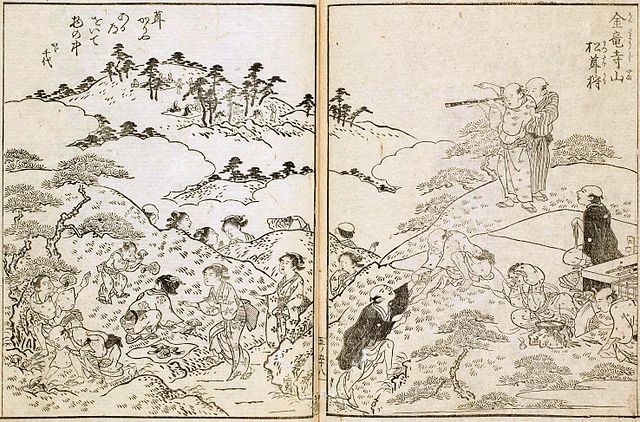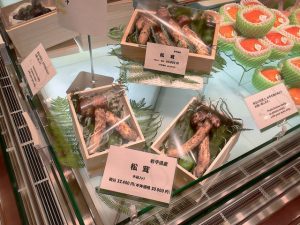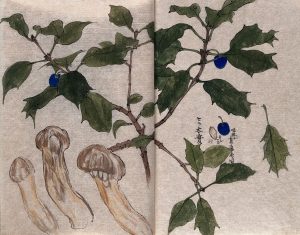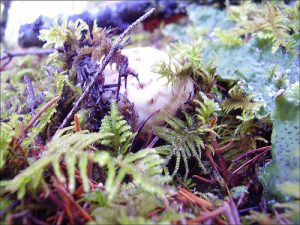Nassima Abdelghafour
The Mushroom at the End of the World. On the possibility of Life in Capitalist Ruins, published by Princeton University Press in 2015, is the latest book by anthropologist Anna Tsing. It is about a wild mushroom called matsutake, which has been appreciated as a delicacy and a fine gift for centuries in Japan because of its aromatic qualities. After World War II, as Japan industrialized, forests were felled and peasants stopped tending to the communal woodlands (called satoyama) in the traditional way. The landscapes where matsutake once thrived disappeared, and by the 1970s matsutake had become very hard to come by in Japan. The book follows the global supply chains that procure matsutake to the Japanese market, connecting precarious foragers in Oregon to Japanese gourmets.
A polyphonic account of precarious life in capitalist ruins
From a situation of ecological destruction and scarcity, the book offers a polyphonic account of precarious life in capitalist ruins. In these stories, capitalist ruins do not lie ahead of us in a gloomy future. They are already there, in patches. In the book, they take the form of abandoned industrial forests in Oregon. Deforestation provides lodgepole pine with the sunlight and mineral soil it needs to grow. Fire suppression policies carried out by  the US Forest Service allows the highly flammable lodgepole pines to grow old. And mature lodgepole pine root systems are great hosts for matsutake mushrooms.
the US Forest Service allows the highly flammable lodgepole pines to grow old. And mature lodgepole pine root systems are great hosts for matsutake mushrooms.
From the beginning of autumn to the first snow, precarious people settle in the Deschutes forest, creating an atmosphere reminiscent of the gold rush. There are South-Asian refugees from Hmong and Mien ethnic minorities, white veterans and non-conformers, some undocumented Latinos and Native people as well. These different crowds do not mingle so much. They all make a living from picking or buying matsutake. The pickers search for mushrooms and sell them every night to independent buyers. The buyers are as precarious as pickers: they hang around in the forest all day and buy mushrooms to immediately resell them to trading companies’ field agents.
Anna Tsing argues that capitalism feeds off these informal picking and buying activities, through a process she calls “salvage accumulation”. It refers to the transformation of matsutake mushrooms into commodities, and to the transformation of foraging into capitalist wealth. While Tsing does not explicitly define the realm of capitalism, or explain why commercial picking stands out of it in the first place, the vivid descriptions of matsutake picking and buying she offers do stress the non-capitalist nature of these activities.
The unscalable economy of matsutake
Commercial picking is contrasted to wage-earning labor in an interesting way. Neither matsutake nor matsutake pickers and buyers can be domesticated into a scalable matsutake production economy. Matsutake only grows wild, in symbiosis with other species. Pickers reject the discipline and hierarchy of formal employment. To put in Marxist terms – as Tsing does – the pickers and buyers she meets in the woods are not alienated at all. The search for matsutake, as well as the sorting of mushrooms are compared to a dance, skillful and livened up with a personal style. Finally, commercial picking is meaningful to people. It is often experienced as an exercise of freedom and cultivating nostalgia. Freedom and nostalgia are interpreted and enacted in many different ways. Old South-Asian ladies escape their urban life to enjoy the village atmosphere of pickers camps. White veterans assert a virile and resourceful attitude reminiscent of the American frontiersmen imaginary. Hmong and Mien minorities who fought against communism during  Indochinese wars enjoy their freedom to do business as they please and to engage with people within their own ethnic group. For White and South-Asian veterans alike, mushroom picking often involves a tamed reenactment of war memories.
Indochinese wars enjoy their freedom to do business as they please and to engage with people within their own ethnic group. For White and South-Asian veterans alike, mushroom picking often involves a tamed reenactment of war memories.
The excitement of hunting for matsutake continues during the evening sale. Surprisingly, buyers do not try to lower the price of matsutake. They offer pickers an “open-ticket” deal. It means that if the price of matsutake rises over the course of the evening, a picker can come back to the buyer and claim the difference. So, buyers are not trying to extract as much value as possible from the pickers’ work. They try to buy as much matsutake as possible, to resell to a trader’s field agent at the end of the night. Part of their expertise consists in seducing pickers into selling to them rather than to others, by treating them to meals or appealing to ethnic or kin relationships. They may even increase the price to outcompete the other buyers, in agreement with the field agent they want to sell to, or at their own risk. Then they skillfully sort the mushrooms according to size and grade, to adjust the price. Importantly, the sale involves excitement and effervescence. It is a performance that pickers enjoy and that contributes to make matsutake picking interesting to them.
When buyers sell to field agents, matsutake starts its transformation into inventory. Anna Tsing shows how mushrooms are brought to warehouses where they are sorted again, before being shipped to Japan. This time, there are sorted and packed by authentic alienated wage-workers who, contrary to buyers, do not care about matsutake at all. This standardization process integrates matsutake into a global supply chain, a business arrangement that epitomizes capitalism.
Supply chain capitalism as a heterogenous assemblage of patches
A chapter called “Between the dollar and the yen” is dedicated to explaining how supply chain capitalism developed in Japan not as a typically Japanese thing, but as a result of repeated encounters between Japan and the US over the course of the 19th and 20th centuries. Supply chains consist in business arrangements led by bankers and traders, who develop an expertise in outsourcing resources and labor abroad for the Japanese market, and even for exportation. These global supply chains are geared at extracting as much value as possible from distant places, with no consideration for ecosystems, working conditions or local politics (cf. destruction of the Kalimantan forest and despair of the Dayaks in Anna Tsing’s  Friction: An Ethnography of Global Connections, Princeton University Press, 2005). Things and labor are extracted from the local assemblages that enable them in the first place, to be turned into inventory and capitalist assets.
Friction: An Ethnography of Global Connections, Princeton University Press, 2005). Things and labor are extracted from the local assemblages that enable them in the first place, to be turned into inventory and capitalist assets.
Anna Tsing shows that capitalism feeds off these pericapitalist patches, where scalable organizations of labor could not succeed in extracting value. These pericapitalist spaces are ambiguous: they are neither completely in nor completely out of the capitalism network. But she chooses to emphasize the heterogeneity and diversity of the world, by describing it as an assemblage of patches. The description of capitalism coexisting with its own ruins in undetermined assemblages allows her to do away with the teleological idea of progress. Tsing describes a dynamics of ruination where stories of decay and stories of renewal riot together. The future is freed from the humanist promises of progress as well as from prophecies of doom. She suggests an open-ended future that stems from an already multiple present. In the stories as she tells them, we learn as much from thinking geographically as we do by thinking historically. Global stories must be told from the edges and from the margins if we want to learn something new about them. Telling stories by patches allows describing a heterogeneous modernity that does not imply defining a western “we” and a global “them” – and personally I find it very pleasant.
Renewing the alliance between social sciences and natural sciences?
The book can be read as an invitation to rethink both our research methodologies and our political imaginaries around a renewed alliance between social sciences and natural sciences. First, along with other authors (among whom Bruno Latour and Donna Haraway), Anna Tsing proposes to abolish the segregation between human and non-human protagonists when describing world-making projects. She argues that without the idea of human progress, this separation does no longer make sense. She proposes a humbler version of change that results from unintentional  collaborations between humans and non-humans. This way of telling stories undermines the idea of pure wilderness. The Deschutes forest, in Oregon, became an attractive forest to white settlers only because the Klamath native people had been tending to it for centuries before the Whites arrived. The satoyama woodlands in Japan degraded when peasants abandoned it. Landscapes are shaped jointly by humans and other living things, in sometimes unpredictable ways. And some of these landscapes suit the growth of matsutake.
collaborations between humans and non-humans. This way of telling stories undermines the idea of pure wilderness. The Deschutes forest, in Oregon, became an attractive forest to white settlers only because the Klamath native people had been tending to it for centuries before the Whites arrived. The satoyama woodlands in Japan degraded when peasants abandoned it. Landscapes are shaped jointly by humans and other living things, in sometimes unpredictable ways. And some of these landscapes suit the growth of matsutake.
Matsutake makes a good case for considering the agency of non-humans very seriously. It is resilient enough to grow on the premises of a nuclear explosion, and in the same time, it stubbornly resists domestication. It needs some human disturbance to thrive, but it will only grow as part as an extended mycorrhizal symbiosis involving multiple trees and fungi exchanging nutrients and information with each other. They grow so close that the fungi and the roots of the trees are entangled at the cellular level. Each individual matsutake is actually a fruiting body of a mycorrhizal encounter between different species.
In the interlude called “Tracking”, Tsing elaborates on this idea of encounter applied to natural sciences. She gathers examples that downplay the role of individual species in evolution. In many cases, it is a relation between several species that matters for understanding evolution patterns. If there is something such as natural selection, it may apply to undetermined encounters rather than to self-perpetuating genetically defined species. She suggests that the understanding of biological processes might benefit from relying more on natural history description, sealing, in a way, a closer methodological alliance with anthropology.
From anthropology of science to anthropology with science
Matsutake spread across the northern hemisphere along patterns that remain partially mysterious to human researchers, that she follows throughout the book. In a chapter called “Science as translation”, Anna Tsing offers an essay of post-colonial anthropology of science. She shows how different national stakes and forestry politics shape different  matsutake sciences in the US, China, Japan and Korea. And she shifts from anthropology of science to a sort of anthropology with science in a beautiful chapter called “Flying spore”. From various interviews with scientists, she recreates a polyphonic state of the art on the question of matsutake reproduction and evolution. In doing this, she really gives an opportunity to the non-human side of the matsutake story. The beauty of this chapter is that from confronting the researchers’ hypotheses on matsutake, Tsing reformulates their findings in terms that resonate with her own work. Matsutake can reproduce sexually, or by cloning, and even by something that is halfway between these two options, like sexually reproduce with itself. Matsutake reproduction is also a matter of indeterminate encounters and collaborations, and it can be regarded as a historical process. Tsing invites us to practice “the arts of noticing”, that combine attentive ethnography with natural history.
matsutake sciences in the US, China, Japan and Korea. And she shifts from anthropology of science to a sort of anthropology with science in a beautiful chapter called “Flying spore”. From various interviews with scientists, she recreates a polyphonic state of the art on the question of matsutake reproduction and evolution. In doing this, she really gives an opportunity to the non-human side of the matsutake story. The beauty of this chapter is that from confronting the researchers’ hypotheses on matsutake, Tsing reformulates their findings in terms that resonate with her own work. Matsutake can reproduce sexually, or by cloning, and even by something that is halfway between these two options, like sexually reproduce with itself. Matsutake reproduction is also a matter of indeterminate encounters and collaborations, and it can be regarded as a historical process. Tsing invites us to practice “the arts of noticing”, that combine attentive ethnography with natural history.
Story-telling as a method
Anna Tsing also enjoins us to use story-telling as a method. As a reader, I take these entangled stories as an opportunity to multiply the connections between the different patches she describes. There is no logical machine, as she warns us in the beginning, but there are riotous causality relationships that interplay in a way that is both unsettling and profoundly satisfying.
This text was presented by Nassima Abdelghafour as an introduction to the session of the “Guests” seminar welcoming Anna Tsing on 4 June 2018.

Photo #1: Picture taken from Michael Drevenstedt, “Matsutake trip“, 2017. CC, BY.
Photo #2: 丹羽桃渓, Matsutakegari, Matsutake mushrooms Picking in the 18th century Japan. Public domain.
Photo #3: Toyohara, 松茸, “Expensive“, Tokyo, 15 septembre 2015. BY, NC.
Photo #4: “A branch of holly (Ilex species) with blue berries and three ito mushrooms (Armillaria matsutake)“, Watercolour, Wellcome Collection. CC, BY.
Photo #5: Paris Sinclair, “Shy Matsutake“, 3 novembre 2006, BY, SA.
Photo #6 : “Session of the “Guests” seminar welcoming Anna Tsing”, Paris, 4 June 2018. Photo credit: Mathieu Baudrin

